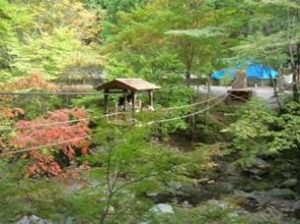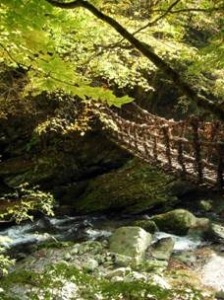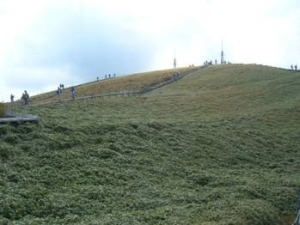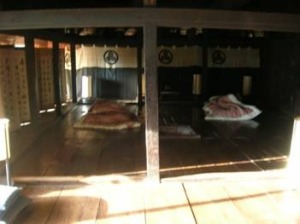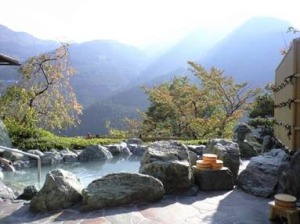Azure waters, extremely old people and the Death Bus.
If you live or have ever lived in one of the urbanized areas of Japan, you’ve probably been pushing through a throng of shoppers who are walking at speeds somewhere between ‘approaching the sound-barrier’ and ‘narcoleptic snail amputee’ when a thought strikes your frazzled brain: “I hate everyone.” It’s not a direct, focused anger, but rather a general antipathy towards all things noisy and pushy. When you get to that point, and you start to contemplate random acts of violence in retaliation for someone taking more than six seconds to buy a subway ticket, it might be time to take a break.
May I make a recommendation?
Iya Valley is known as the ‘Tibet of Japan’, because it’s under the control of the Chinese. No, actually it’s called this because it is very remote, quiet and full of wrinkly people. The valley lies somewhere near the centre of Shikoku and can be reached from Kobe via a 3-hour bus-trip. The bus takes you over the impressive Awajishima bridge, the unexciting whirlpool, and the relatively deserted Awaji Island, which tops my list of islands most likely to contain a secret military base. When you arrive in the foothills of Iya Valley, you’ll change to a charming single-car train that will shuttle you up into the mountains where the air is so still and silent that you can hear a single-car train approaching from miles away.
The train ride is an important part of the experience of Iya Valley. You’ll be whisked along the edges of precipitous gorges and through dark tunnels. You’ll enjoy the relaxed manner in which the locals remove their shoes and put their feet up on the train seats. You’ll remember that while it’s quaint and charming for them to do this, no one wants to see your huge foreign showboat-sized feet in public, so keep them in your shoes. Most importantly, you’ll see the water. You will remember the water for the rest of your life.
I recommend getting a mask to prevent bugs from climbing into your mouth while you are gasping
According to the shredded remnants of high school geography and science, the mountains and riverbeds of Iya are mostly composed of dark shale that is unusually rich in copper. This copper oxidizes on the surface of the riverbeds and transforms the water of Iya’s rivers into beautiful azure ribbons, greener than the sky, bluer than the cheap, tawdry waters of the Caribbean. This gorgeous view is only occasionally interrupted by thrill-seeking Japanese tourists, holding on for dear life as their inflatable rafts barrel downstream at near-walking speed. Of course, we went when in autumn when the water was very low, but I’m sure it gets absolutely terrifying…if you get attacked by a lost polar bear (Ha ha. Lost in-joke)
Anyway, at the end of the train ride you’ll mostly likely be deposited at Obokke station. If that’s not where you get off, don’t blame me. The area around the station is one of the urban centers of Iya that are going absolutely nowhere. You can shop ‘til you get bored at ‘MART’ and the imaginatively named ‘MART 2’. You can also catch a taxi if you’re staying in the area. If you’re not staying in the vicinity of the station, you’ll want to catch one of the buses that amble down the hill and then back up it again every couple of hours. These buses venture almost anywhere you want to go in Iya Valley because there is approximately one road, and most of the time it isn’t even wide enough for a horse (a thin horse), never mind a bus. Once aboard the bus you’ll be treated to the local delicacy of the region. The bitter taste of fear. Your bus will lurch along the winding roads that cling to the gorges of the valley like a drunk on crutches. At every corner along the road, you’ll see a convex mirror that your driver will hopefully keep an eye on, since it’s the only warning you’ll have that another car or, god forbid, another bus is coming in the opposite direction. Both vehicles will then come to an immediate halt, so I recommend that you stay seated throughout the ride. Whichever vehicle is closer to one of the many ‘wider than a fridge’ parts of the road that dot the route will reverse to it, allowing the other to pass, although I did get a sense that might makes right.
Look at that road! It’s 6 feet wide!
The buses travel a roughly circular route from the station to Tsurugi-san (Ken-Zan to the locals) and back again. Along the way you can stop off at a number of tourist attractions.
The bridges:
Iya Valley was originally settled by a samurai clan on the run from some other samurai clan in a game of Tag that I think everyone now agrees got way out of hand. The fleeing clan, who went by the name of ‘Not-its’ came up with a sneaky way of ensuring their survival in case the ‘It’ clan ever followed them. They built numerous rope bridges across the gorges of the valley as a convenient means of transport and scaring people with vertigo, and decided that if the ‘It’ clan ever found them (unlikely, as the ‘It’ clan soon decided that it was bored of this game and went back to its Lego set), they would detonate the C4 at the base of the bridge supports, destroying the bridges and making pursuit impossible.
The bridges are made of vines, but have been subtly reinforced with steel wires, so there’s no danger of them falling into the gorge below. The same cannot be said of you. There is a good hand width of empty space between each of the slats that make up the floor of the bridge, so watch where you put your feet. It’s not really all that terrifying, but you wouldn’t know it from the way some tourists inch their way across crabwise. This either ruins a great many beautiful photographs or makes a great many amusing ones, depending on your point of view. The two smaller bridges, which are closer together, also feature a kind of boxcar transport system where you can sit in a small palanquin and pull yourself across the gorge with a rope.
It’s no Space Mountain, but it’s fun
Hint: Your name, your quest, blue.
The mountain with the sword story:
One of the main attractions of Iya valley is Tsurugi-san, or Ken-Zan. Legend has it that a famous guy, currently dead, buried a fabulous sword somewhere on the slopes of Ken-Zan, and it remains there to this day, howling at the moon and feasting on living flesh. Not really. If it does exist, it’s probably in a box, and no matter how invaluable the sword might be if you find it, you’re not going to get to keep it and I’d much rather have all the tourist money that has been generated by the story. Feel free to feed the beast when you get to the parking area of the mountain by buying Ken-Zan mocha, hats, sticks, pins, picture books, maps, mail-order brides, snow globes, weasel-coffee and other omiyage that will increase the weight of your bags threefold.
Actually, I recommend getting all that stuff after you go up the mountain. If you are an outdoorsy, energetic, and dynamic person, you can walk up the side of the mountain in about an hour and a half. It is, by all accounts, an easy and relaxing stroll rather than a hike. If you’re like me, you can take the cable-car half-way up and then saunter the remaining 30minutes in about an hour. This may sound strange, but I assure you that hiking books are not to be trusted, because they are written by the kind of man that has a 5 O’clock shadow twenty minutes after they he shaves, and the kind of woman who tells that man what to do.
Once you summit the mountain, you can relax and tuck into whatever food you brought with you. If you didn’t bring any food with you, you can take out a bond on something at the store just below the summit or you can beat someone up and take theirs. I recommend going for people with glasses. They never expect to get hit.
The summit of Ken-Zan. The only place you’ll find any large number of tourists in Iya Valley
You can walk along to the summit of that mountain too, if you want. I have a picture.
After you’ve had your fill of the spectacular views available from the summit of Ken-Zan, it’s time to pack up and go back down to the parking lot. On the way, I recommend that you indulge in a little fantasy in which you notice a tiny glint of metal glinting in the slope of the mountain, and upon closer investigation find the fabled lost sword of that dead guy. Just watch out for C4 traps. Those samurai were crafty buggers and they built things to last.
Other recommendations:
Those of you still reading have probably given up on finding any factual, useful information. I congratulate you on your acceptance of reality, but would like to give you’re a fuzzy idea of some of the other delights to be had in Iya Valley, if only enough for you to be prompted to pull out a real travel guide and do some actual research. That’s right. I’m not going to do it all for you. Why are you so lazy?
Sheesh.
Chiiori house.
Originally bought in the 70’s by that dude who wrote Dogs and Demons, Chiiori house is one of the remaining two traditional thatched roof houses in Iya Valley. It’s a sort of guest-lodge/commune that doesn’t really fit into any of the preconceived boxes of accommodation, one of the reasons that it’s so worth visiting. At about 4000yen per person per night, you’ll get to experience life in a traditional old-fashioned Japanese house, plus kitchen, western toilet and electricity. Everyone sleeps in a large central room on futons, with folding blinds dividing up the space so that you won’t be treated to a view of some stranger’s mouth-breathing. If you get hungry, you can feel free to grab something from the snack-drawer and everyone pitches in to cook dinner night. There’s a good chance dinner will include some fresh vegetables from the gardens surrounding the house. The house is co-run by an American named Mark and a Japanese guy named…something Japanese, and they’re both very accommodating and friendly. Chiiori house is about as far from city life as you’re going to get while still being comfortable, so I highly recommend that you go there before you have a nervous breakdown. In the early mornings, the house drifts just above the clouds that slowly dissipate as the sun comes up. The gurgling river is a ten minute walk downhill, and a good opportunity to get up close and personal with the pristine blue water. At night you can huddle around the indoor fire-pit and enjoy a beer or chu-hai with the other guests, and when you get tired you can retire to a warm futon, safe from the vampires that lurk outside in the bushes.
The rock museum:
About 10minutes walk from _______ station is a rock museum. If you are interested in rocks, you will be impressed by their lovely collection and ‘Iya Valley rock-hunting-adventure-video’, narrated by a Japanese Indiana-Jones-alike who is entirely hilarious. They have pretty rocks, ancient rocks and rocks that glow under UV light. They also have an omiyage store in which you can pauper yourself.
If you don’t like rocks, don’t go.
Onsens:
There are a number of excellent onsens in Iya Valley, many of them operated by hotels that they are adjoined to. We visited one that I can’t remember the name of, and Hikyo no Yu. Hikyo no Yu is operated by a very snazzy hotel that charges 15000yen per night and well worth it if you fancy some dinner that is half-delicious and half-completely unrecognizable. Besides the three different types of bath available in this onsen, there is also a salt sauna in which you cover yourself in rough salt, sweat for a bit and then go outside and wash the salt off, along with a couple of layers of skin. One technological triumph of the Hikyo no Yu is a circular shower with perforated metal rings that surround you from your feet to your chest and spray you with enough forces to remove any tattoos your may have. I recommend you use your towel and hands to cover any sensitive parts of your anatomy that you might want to continue to work after your shower.
For sheer novelty value though, you can’t beat the Kurabashi onsen, operated by the Kurabashi hotel. Upon entering, you can take an arthritically slow cable car up the side of the mountain to the baths. The baths are fairly small, and interestingly includes a unisex section for anyone feeling racy. The view from the baths is fantastic, but I’ll let the picture do the talking because this article is already 2000 words long.
The water of Kurabashi onsen has a soapy feel to it. I suspect it is slightly alkali and melts the skin off your body, layer by layer
A note on old people:
You will see a lot of them in Iya Valley. The large number of old people you will see will be accentuated by the extremely small number of young people you will see. I bet you sometimes wonder where all those young, attractive people who live in Kobe and Osaka come from? The answer is Iya Valley and countless other inaka areas just like it that send their young people off to the big city to get an ejumacation and then never see them again. The only young people you will see in Iya Valley are working in the tourist industry. Everyone else is worryingly decrepit, and despite the ubiquitous construction projects underway all around the area, signs of decay are everywhere. Empty houses, abandoned cars and silent streets testify that that this area’s busy days are long behind it and what will happen when the current generation of old people finally go up to that big onsen in the sky is a question for someone smarter than me. My guess is something like that scene in cocoon when the aliens arrive and everyone gets younger again.
Don’t forget the omiyage!
I hope this article has given you a small, inaccurate, populated-by-vampires-view of Iya Valley that will drive you to the Let’s Go, Japan (better name: Let’s Going, Japan) or whatever other travel guide I know is on your bookshelf, to really find out what there is to see. We went in early autumn, but I’m sure the valley will be stunning in winter and cool in summer. I hardly covered the river rafting, which is apparently fantastic in the spring I also skimped on the fascinating old-fashioned bus day-trip that will take you to most tourist attractions, feed you the local soba and dangle you entertainingly over a ledge. I didn’t want to talk about them too much because I didn’t do them while I was there, and I’ve always been a firm believer in ‘write what you know’.
In the future, you can look forward to articles from me about space travel on a shoestring, a step-by-step walkthrough of the Minotaur’s lair and the ins and outs of the hokey pokey, which my culture regards as an express-train to eternal damnation…or perhaps that’s Ouija boards.



